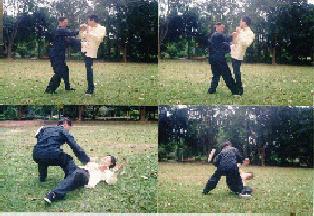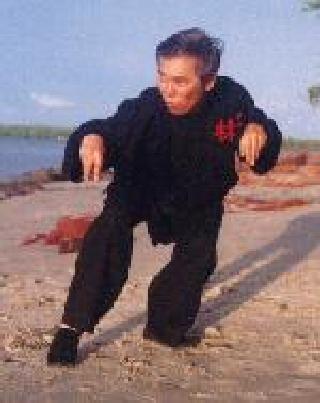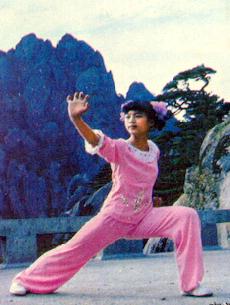SELECTION OF QUESTIONS AND ANSWERS
MAY 1998 PART 1

Applying “Repulse Monkey” in Yang Style Taijiquan to overcome a ferocious Siamese Boxing kick to the side-ribs
Question 1
I wanted to see if you had any suggestions on how to “learn” to perfect the individual postures/techniques. Also, I've recently read your book, “The Complete Book of Tai Chi Chuan” and I'm currently reading “Chi Kung for Health & Vitality”. Having read up to chapter 9, I'm now wondering how I'm going to fit all my practice in!
— John, Australia
Answer
All real Taijiquan masters have advised that the form is the least important aspect of Taijiquan. What is more important is the training of energy and mind. Nevertheless, that does not mean that form is not important at all.
As you already have my book, “The Complete Book of Tai Chi Chuan”, follow my suggestions in Chapter 5, and practise the exercises mentioned therein for at least 3 months before proceeding to any other Taijiquan forms. As I have advised in the Chi Kung book, practise only one or two chosen exercises. You will certainly get more benefits this way than practising ten or twenty at the same time.
Question 2
The current plan is to do the Tai Chi form every morning and I was going to alternate between working on the Tai Chi form postures and the Chi Kung exercises (as well as the Abdominal Breathing) every other night.
Now, is this regular enough practice/exercise to get the benefit from the Chi Kung or should I practice some other way? I'd appreciate any suggestions you might have, 'coz I'd really like to do both the Tai Chi and the Chi Kung correctly, although I realize I'm not going to be perfect in either of them for quite a long time.
Answer
In the way you practise with the large number of exercises, you will only succeed in learning techniques, but not getting the real benefits of chi kung or Taijiquan. This, unfortunately, is the usual way many people, especially in the West, follow. This is one reason why there are so few masters although there may be many people practising the art.
Some even start to teach chi kung or Taijiquan after practising for only a few months, and if they carry on teaching for a few years (during which time they seldom improve their own performance) they would call themselves masters, although actually their level of attainment is low. They may talk about chi kung or Taijiquan, but they would not be able to demonstrate the benefits that these arts are purported to give, such as having excellent health, being able to manage their energy flow, possessing internal force and being combat efficient.
Abdominal Breathing should be attempted with a master's supervision because it is easy to practise wrongly with incidious effects. You will get better result and in shorter time if you attempt Abdominal Breathing only after you have practised Dynamic Patterns or Self-Manifested Chi Movement for a few months.
You have only started Taijiquan for six months, yet you are attempting a range of exercises real masters would not do until after many years. I can understand your and many other people's impatence to learn many different exercises, because I myself was in the same situation before. The big difference is that it took me more than 10 years to discover and appreciate the secret to mastery of chi kung, Taijiquan or any art, whereas you are so lucky to be told this secret after only six months, although you may not beleive that this is a secret.
The secret appears so simple, but is very difficult for many people to follow. In your case, it is practising, practising and practising a few selected techniques (such as “Carrying the Moon” in chi kung and “Taiji Starting Pattern” in Taijiquan) daily for at least 6 months, and forgetting about other techniques for the time being. What you need is some consistent effort and six months' time to test whether what I have said is true.
Please don't mistake my sincere advice as harsh words. From your e-mail, I know you are sincere in wanting to improve your art and humble enough to learn. Should you become a master one day, when you look back you will realize that what I have said will probably be one of the best pieces of advice you have ever received from someone who himself has travelled the same way.
Question 3
Many “mysterious” illnesses appeared - losing 30 lbs in one month, jaundice, symptoms reminiscent of epilepsy, yet doctors could not find any cause. Through years of erratic and violent mood swings I alienated myself from everyone. I am experimenting with visualizations/concentrations of energy inflating my body and squeezing this energy into my body.
— Josa, USA
Answer
Chi Kung masters (real masters, not self-taught impersonators) have warned that visualization and concentrations of energy must be done with a teacher's supervision, yet you are so unwise as to experiment with these practices.
Question 4
How do I convert the aggressive/sexual energy into a form which is less disruptive and more healing? Could the inflating/sqeezing visualization be improved upon? Are there any visualizations and/or other refinements that could improve my practice?
Answer
If you can learn this through an answer via an e-mail, there would be thousands of chi kung “masters” jostling in the street. Do not continue this practice without proper supervision, if you do not want to head towards serious trouble. There are many visualization exercises and other refinements, but they are not meant for someone like you who have not learnt chi kung properly.

Sifu Wong demonstrating a Monkey pattern
Question 5
The standing feels good, rejuvenating. The three-circle can at times be draining, and I only practice a few minutes at the end of a session of cosmos stance. You mention “dangers” surrounding the practice of abdominal breathing. Could you elaborate and or help me to learn this art?
Answer
Do not continue these exercises! What you need is clearing yourself of energy blockage, not adding energy (which these exercises would do) to intensify your blockage. You are an excellant example of someone in great dangers. Do not add dangers to your precarious situation. Go and seek the help of a GENUINE chi kung master
Question 6
I am intrigued by the Cosmos Palm and would like further information on the training involved. This art seems to call to me. I am currently learning the massage and aim to aid others to heal trauma stored in the body, facilitating the awakening to their soul as I do to my own.
Answer
The Cosmos Palm is a wonderful art, but it is not suitable for you at present. You must realize that a healer is one who has undergone many years of proper training under a master. Honestly ask yourself as follows: Is this healing art capable of overcoming health problems which even people who have been professionally trained for many years like doctors and psychiatrists, cannot overcome? If so, can this healing art be acquired in a self-taught manner in a matter of a few weeks?
But more importantly you must heal yourself first. If you really want to be a healer and help others, you yourself must be healthy first, and be willing to spend a few years to undergo the necessary training. If you are unwilling to train under a master but imagine you can become one and heal others of illness that even conventional medicine finds difficult, merely by reading some books and trying out some exercise which you yourself do not know well, you will only contribute to the rapid growth of bogus healers.
Question 7
Is it possible for me to go to Shaolin Monastery for 2 months and practise martial arts?
— Alessandro, Italy
Answer
Shaolin Kungfu is not taught at the Shaolin Monastery of China today, but modern wushu is taught in the various schools around the monastery, and the instructors are often monks from the monastery. But modern wushu is different from traditional kungfu. Unlike kungfu where combat efficiency and spiritual development are important, modern wushu is more like a sport, and is generally for demonstration.
Question 8
Our system is the merging of Wing Chun and Korean Hapkido (with the Chinese style more predominant). I am required to do a paper and write a form in my chosen animal style and that style is Monkey Style. Any information or leads would be greatly appreciated.
— Todd, USA
Answer
There are schools that use the monkey style of kungfu as the sole or main form; and also there are schools that use the monkey style as one of their major forms. The two most famous schools using the monkey style as the sole form are the Da Sheng Men and the Hou Quan.
Da Sheng Men means “School of the Great Saint”. The Great Saint refers to the Monkey God, who in Chinese legends was (and still is) a great warrior with supernatural powers and who attacked the heavenly palace of the Jade Emperor. The heavenly imperial army could not stop him. Finally he was subdued by the Buddha (not the historical Buddha in the person of Guatama, but the divine, eternal Buddha). The Monkey God then protected the great Chinese monk Xuan Zhang in his pligrimage to India to bring Buddhist scriptures to China.
Hou Quan means “Monkey Kungfu”. There are five different types of monkeys in this style, namely “Standing Monkey”, “Stone Monkey”, “Wooden Monkey”, “Intelligient Monkey” and “Drunken Monkey”. While the monkey style is generally meant for smaller size persons, the Standing Monkey is specially designed for bigger size persons; Stone Monkey is noted for its force; Wooden Monkey for its agility; Intelligent Monkey for its tactics and strategies; and Drunken Monkey for its deceptive footwork.
The monkey style is found in many other schools of kungfu. There are many monkey style patterns in both Northern and Southern Shaolin. Prtaying Mantis Kungfu incorporates the agile footwork of the monkey style. Lama Kungfu, which is popular in Tibet, is mainly a combination of the Crane and the Gorilla patterns.
Monkey style is deceptive and versatile. Often an opponent may think that he has forced a monkey style exponent to a dead end, but by an unexpected twist the monkey stylist could turn an apparently hopeless situation into victory. A strong, big sized opponent may use all his strength to punch or kick a monkey stylist, but the latter seems to avoid or deflect the attacks with little effort.
Both Wing Choon Kungfu and the Monkey Kungfu are well known as effective martial arts for the smaller sized against the bigger and physically stronger, but they generally make use of different principles to achieve this purpose. Hence there is not much monkey style characteristics in Wing Choon Kungfu, except that the “Phong Sau” or lower hand guard of Wing Choon Kungfu is quite characteristic of the monkey. Indeed a comparative study of Wing Choon Kungfu and Monkey Kungfu is very useful in illustrating the various techniques and tactics Chinese masters have devised for the small against the big and strong.
Taekwondo almost never uses monkey style characteristics. In fact the high kicks and clenched fists commonly used in Taekwondo would be quite incompatible with typical monkey style movements. Boxing, on the other hand, employs typical monkey style characteristics. Although kicking attacks are principal means of attack in both Taekwondo and Siamese Boxing, their kicks are characteristically different. Siamese Boxing is very powerful and vicious, but, perhaps surprising to many people, their fighting methods are “rou” or “soft”. For example, if you observe their fighting carefully, a good Siamese Boxer never blocks his opponent's kicks with his hands; to do so would have his bones fractured or wrists dislocated.
Question 9
My mother and grandmother both suffer from rheumatism. They have tried numerous ways to relieve some of their pain, but none seem to work. I read on your webpage that you have helped people to cure this ailment. Is this true? How do you do it? I don't mean to question your methods or motives out of disrespect, just curious.
— Matt, USA
Answer
There is no doubt that rheumatism can be overcome by practising chi kung. Hundreds of people have done that. But you must practise genuine chi kung, not just some gentle exercise that claims to be chi kung. The crucial test of whether the exercise is chi kung is whether the practitioner can actively manage his or her energy flow. Genuine chi kung masters are quite rare nowadays.
Rheumatism is the result of energy blockage in or between body cells. Hence vital energy (which is more than just oxegen) cannot flow through, resulting in an inability to flush away toxic waste and to bring nutrients to the cells, and such a condition manifests as rheumatic pain. Chi kung is an excellent way to clear the blockage.

Modern wushu, which is a magnificient art, is different from traditional kungfu
Question 10
I would like to learn Law Horn Kuen and Scissors Fist Set. I have heard that these are very old and traditional sets of Shaolin. There are no schools around here that teach these styles. How can I learn them? Do you know of any instrctional videos or books I can buy?
— Damon, country not mentioned
Answer
If you want good result you must learn from a master or at least a competent instructor. Unless you are already accomplished in kungfu, what you learn from videos or books is only some form of kungfu dance.
Moreover, form is only one aspect of kungfu, and it is probably the least important aspect. You should, among other things, learn how to apply your kungfu for self defence as well as for daily living, develop internal force and cultivate spiritually.
Question 11
Ultimately, my goal is to find a good tai chi or chi kung master and I am a bit comfused on how to go about it. This page helped me to make sense out of what it is that I'm looking for, and it is that spiritual or “mind” chi kung you describe. What questions should I ask a prospective teacher to help ensure my satisfaction with their interpretation of the art?
— Donald, USA
Answer
My webpage Qualities of a Good Master provides some useful information for your need. But of course good masters are very rare nowadays.
What questions you should ask depends on numerous variables like your understanding of the art, your abilities and needs, your immediate objectives, your long-term aspirations as well as whether the teacher in question is a genuine master or a self-taught instructor who has just completed a week-end seminar on chi kung conducted by another self-taught instructor.
For example, if you, like most people in the West, regard chi kung as some form of gentle exercise that you can readily pick up from a gym or from a book, you may ask something like “How many techniques I am going to learn from you and what is your fee?” If you regard chi kung as a rare opportunity for personal development and the teacher you are talking to is one who can make this come true, you may ask “Master, I am prepared to train hard, can you please accept me as a student and teach me according to what you think is best?”
Facing a self-taught instructor, you should politely ask questions like “Can practising chi kung cure my backache?”, “How and why chi kung can cure backache?” and “Can you please give some examples of people whose backache you have cured?” Asking a genuine master such questions, even if you do so politely, is both unnecessary and rude.
